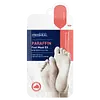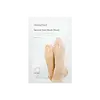What's inside
What's inside
 Key Ingredients
Key Ingredients

 Benefits
Benefits

 Concerns
Concerns

 Ingredients Side-by-side
Ingredients Side-by-side

Water
Skin ConditioningCaprylic/Capric Triglyceride
MaskingGlycerin
HumectantMethylpropanediol
Solvent1,2-Hexanediol
Skin ConditioningPolysorbate 60
EmulsifyingGlyceryl Stearate
EmollientCetearyl Alcohol
EmollientParaffin
PerfumingPanthenol
Skin ConditioningOlea Europaea Fruit Oil
MaskingMangifera Indica Seed Butter
Skin ConditioningMacadamia Integrifolia Seed Oil
Skin ConditioningButyrospermum Parkii Butter
Skin ConditioningZingiber Officinale Root Extract
MaskingUrea
BufferingRubus Idaeus Fruit Extract
AstringentMentha Arvensis Extract
MaskingAcacia Senegal Gum
MaskingBeta-Glucan
Skin ConditioningAllantoin
Skin ConditioningButylene Glycol
HumectantSalicylic Acid
MaskingPalmitic Acid
EmollientDimethicone
EmollientPEG-100 Stearate
Stearic Acid
CleansingSorbitan Sesquioleate
EmulsifyingSodium Polyacrylate
AbsorbentCarbomer
Emulsion StabilisingTromethamine
BufferingEthylhexyl Stearate
EmollientMenthol
MaskingEthylhexylglycerin
Skin ConditioningTrideceth-6
EmulsifyingTocopheryl Acetate
AntioxidantDisodium EDTA
Parfum
MaskingWater, Caprylic/Capric Triglyceride, Glycerin, Methylpropanediol, 1,2-Hexanediol, Polysorbate 60, Glyceryl Stearate, Cetearyl Alcohol, Paraffin, Panthenol, Olea Europaea Fruit Oil, Mangifera Indica Seed Butter, Macadamia Integrifolia Seed Oil, Butyrospermum Parkii Butter, Zingiber Officinale Root Extract, Urea, Rubus Idaeus Fruit Extract, Mentha Arvensis Extract, Acacia Senegal Gum, Beta-Glucan, Allantoin, Butylene Glycol, Salicylic Acid, Palmitic Acid, Dimethicone, PEG-100 Stearate, Stearic Acid, Sorbitan Sesquioleate, Sodium Polyacrylate, Carbomer, Tromethamine, Ethylhexyl Stearate, Menthol, Ethylhexylglycerin, Trideceth-6, Tocopheryl Acetate, Disodium EDTA, Parfum
Water
Skin ConditioningDimethicone
EmollientButylene Glycol
HumectantGlycerin
HumectantAlcohol
AntimicrobialCetyl Ethylhexanoate
EmollientGlyceryl Stearate
EmollientPEG-100 Stearate
Betaine
HumectantCetearyl Alcohol
EmollientPhenoxyethanol
PreservativePolyacrylate-13
Polyisobutene
Acrylates/C10-30 Alkyl Acrylate Crosspolymer
Emulsion StabilisingCitrus Paradisi Fruit Extract
Skin ConditioningParfum
MaskingCyclopentasiloxane
EmollientDimethiconol
EmollientPotassium Hydroxide
BufferingPolysorbate 20
EmulsifyingBenzyl Benzoate
AntimicrobialDisodium EDTA
Urea
BufferingHydroxyisohexyl 3-Cyclohexene Carboxaldehyde
MaskingPolyglyceryl-3 Methylglucose Distearate
EmulsifyingCamellia Sinensis Leaf Extract
AntimicrobialCitrus Unshiu Peel Extract
MaskingOpuntia Coccinellifera Fruit Extract
Skin ConditioningOrchid Extract
Skin ConditioningCamellia Japonica Leaf Extract
Skin ConditioningHexyl Cinnamal
PerfumingAlpha-Isomethyl Ionone
PerfumingLinalool
PerfumingCetearyl Glucoside
EmulsifyingMethyl Glucose Sesquistearate
EmollientHydroxycitronellal
PerfumingCoumarin
PerfumingPaeonia Albiflora Root Extract
Skin ConditioningLonicera Japonica Flower Extract
Skin ConditioningSophora Angustifolia Root Extract
Skin ConditioningEvernia Prunastri Extract
PerfumingPrunus Persica Leaf Extract
EmollientIsoeugenol
PerfumingGinkgo Biloba Leaf Extract
Skin ConditioningScutellaria Baicalensis Root Extract
AstringentGeraniol
PerfumingCentella Asiatica Extract
CleansingPortulaca Oleracea Extract
Skin ConditioningBenzyl Salicylate
PerfumingEugenol
PerfumingWater, Dimethicone, Butylene Glycol, Glycerin, Alcohol, Cetyl Ethylhexanoate, Glyceryl Stearate, PEG-100 Stearate, Betaine, Cetearyl Alcohol, Phenoxyethanol, Polyacrylate-13, Polyisobutene, Acrylates/C10-30 Alkyl Acrylate Crosspolymer, Citrus Paradisi Fruit Extract, Parfum, Cyclopentasiloxane, Dimethiconol, Potassium Hydroxide, Polysorbate 20, Benzyl Benzoate, Disodium EDTA, Urea, Hydroxyisohexyl 3-Cyclohexene Carboxaldehyde, Polyglyceryl-3 Methylglucose Distearate, Camellia Sinensis Leaf Extract, Citrus Unshiu Peel Extract, Opuntia Coccinellifera Fruit Extract, Orchid Extract, Camellia Japonica Leaf Extract, Hexyl Cinnamal, Alpha-Isomethyl Ionone, Linalool, Cetearyl Glucoside, Methyl Glucose Sesquistearate, Hydroxycitronellal, Coumarin, Paeonia Albiflora Root Extract, Lonicera Japonica Flower Extract, Sophora Angustifolia Root Extract, Evernia Prunastri Extract, Prunus Persica Leaf Extract, Isoeugenol, Ginkgo Biloba Leaf Extract, Scutellaria Baicalensis Root Extract, Geraniol, Centella Asiatica Extract, Portulaca Oleracea Extract, Benzyl Salicylate, Eugenol
Ingredients Explained
These ingredients are found in both products.
Ingredients higher up in an ingredient list are typically present in a larger amount.
Butylene Glycol (or BG) is used within cosmetic products for a few different reasons:
Overall, Butylene Glycol is a safe and well-rounded ingredient that works well with other ingredients.
Though this ingredient works well with most skin types, some people with sensitive skin may experience a reaction such as allergic rashes, closed comedones, or itchiness.
Learn more about Butylene GlycolCetearyl alcohol is a mixture of two fatty alcohols: cetyl alcohol and stearyl alcohol. It is mainly used as an emulsifier. Emulsifiers help prevent the separation of oils and products. Due to its composition, it can also be used to thicken a product or help create foam.
Cetearyl alcohol is an emollient. Emollients help soothe and hydrate the skin by trapping moisture.
Studies show Cetearyl alcohol is non-toxic and non-irritating. The FDA allows products labeled "alcohol-free" to have fatty alcohols.
This ingredient is usually derived from plant oils such as palm, vegetable, or coconut oils. There is debate on whether this ingredient will cause acne.
Due to the fatty acid base, this ingredient may not be Malassezia folliculitis safe.
Learn more about Cetearyl AlcoholDimethicone is a type of synthetic silicone created from natural materials such as quartz.
What it does:
Dimethicone comes in different viscosities:
Depending on the viscosity, dimethicone has different properties.
Ingredients lists don't always show which type is used, so we recommend reaching out to the brand if you have questions about the viscosity.
This ingredient is unlikely to cause irritation because it does not get absorbed into skin. However, people with silicone allergies should be careful about using this ingredient.
Note: Dimethicone may contribute to pilling. This is because it is not oil or water soluble, so pilling may occur when layered with products. When mixed with heavy oils in a formula, the outcome is also quite greasy.
Learn more about DimethiconeDisodium EDTA plays a role in making products more stable by aiding other preservatives.
It is a chelating agent, meaning it neutralizes metal ions that may be found in a product.
Disodium EDTA is a salt of edetic acid and is found to be safe in cosmetic ingredients.
Learn more about Disodium EDTAGlycerin is already naturally found in your skin. It helps moisturize and protect your skin.
A study from 2016 found glycerin to be more effective as a humectant than AHAs and hyaluronic acid.
As a humectant, it helps the skin stay hydrated by pulling moisture to your skin. The low molecular weight of glycerin allows it to pull moisture into the deeper layers of your skin.
Hydrated skin improves your skin barrier; Your skin barrier helps protect against irritants and bacteria.
Glycerin has also been found to have antimicrobial and antiviral properties. Due to these properties, glycerin is often used in wound and burn treatments.
In cosmetics, glycerin is usually derived from plants such as soybean or palm. However, it can also be sourced from animals, such as tallow or animal fat.
This ingredient is organic, colorless, odorless, and non-toxic.
Glycerin is the name for this ingredient in American English. British English uses Glycerol/Glycerine.
Learn more about GlycerinGlyceryl Stearate is a mix of glycerin and stearic acid.
It is used to stabilize the mixing of water and oil ingredients. By preventing these ingredients from separating, it can help elongate shelf life. It can also help thicken the product's texture.
As an emollient, it helps soften skin and supports barrier-replenishing ingredients.
In cosmetics, Glyceryl Stearate is often made from vegetable oils or synthetically produced.
This ingredient may not be fungal-acne safe
Fun fact: The human body also creates Glyceryl Stearate naturally.
Learn more about Glyceryl StearateParfum is a catch-all term for an ingredient or more that is used to give a scent to products.
Also called "fragrance", this ingredient can be a blend of hundreds of chemicals or plant oils. This means every product with "fragrance" or "parfum" in the ingredients list is a different mixture.
For instance, Habanolide is a proprietary trade name for a specific aroma chemical. When used as a fragrance ingredient in cosmetics, most aroma chemicals fall under the broad labeling category of “FRAGRANCE” or “PARFUM” according to EU and US regulations.
The term 'parfum' or 'fragrance' is not regulated in many countries. In many cases, it is up to the brand to define this term.
For instance, many brands choose to label themselves as "fragrance-free" because they are not using synthetic fragrances. However, their products may still contain ingredients such as essential oils that are considered a fragrance by INCI standards.
One example is Calendula flower extract. Calendula is an essential oil that still imparts a scent or 'fragrance'.
Depending on the blend, the ingredients in the mixture can cause allergies and sensitivities on the skin. Some ingredients that are known EU allergens include linalool and citronellol.
Parfum can also be used to mask or cover an unpleasant scent.
The bottom line is: not all fragrances/parfum/ingredients are created equally. If you are worried about fragrances, we recommend taking a closer look at an ingredient. And of course, we always recommend speaking with a professional.
Learn more about ParfumPeg-100 Stearate is an emollient and emulsifier. As an emollient, it helps keep skin soft by trapping moisture in. On the other hand, emulsifiers help prevent oil and water from separating in a product.
PEGS are a hydrophilic polyether compound . There are 100 ethylene oxide monomers in Peg-100 Stearate. Peg-100 Stearate is polyethylene glycol ester of stearic acid.
Urea is also called carbamide and is the diamide of carbonic acid. In cosmetics, urea is used to hydrate the skin. It also provides exfoliation in higher concentrations.
As a humectant, urea helps draw moisture from the air and from deep within the skin. This helps hydrate your skin. Studies show urea is an effective moisturizer for dry skin conditions. 40% urea is typical in medications for treating eczema and other skin conditions.
Urea has the strongest exfoliation effect in concentrations higher than 10%. It is a keratolytic agent, meaning it breaks down the keratin protein in the top layer of skin. This helps remove dead skin cells and flaking skin.
In medicine, urea has been shown to help increase the potency of other ingredients, such as fungal treatments.
Humans and animals use urea to metabolize nitrogen-containing compounds. Urea is highly soluble in water. Once dissolved, it is neither acidic nor alkaline.
Learn more about UreaWater. It's the most common cosmetic ingredient of all. You'll usually see it at the top of ingredient lists, meaning that it makes up the largest part of the product.
So why is it so popular? Water most often acts as a solvent - this means that it helps dissolve other ingredients into the formulation.
You'll also recognize water as that liquid we all need to stay alive. If you see this, drink a glass of water. Stay hydrated!
Learn more about Water